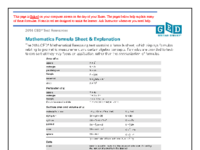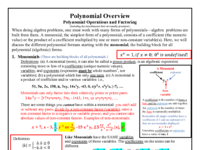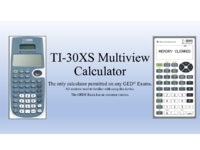
GED Math Resources (PDFs)
GED Requirements Guide ESC1_Math
00 GED Formula Expanded
Do you need more than the official GED formula sheet? This expanded formula list goes beyond the basics. It features all the official [b]GED Formulas, complete with definitions and interactive GeoGebra examples[/b] to aid understanding. What's more, it contains many [b]additional formulas[/b] frequently used on the exam that aren't included in the official formula sheet. To further boost comprehension, you'll discover a wealth of [b]mathematical definitions[/b] designed to clarify GED exam questions, along with crucial [b]arithmetic and geometry concepts[/b] that are tested but not found on the official sheet.
01 Changing written English terms to mathematical equivalence
This document is designed to help you master key math concepts for the GED. Here's a breakdown:[br][list][*][b]Understanding Math Language (Pages 1-2):[/b] The first two pages provide a list of words that often signal specific mathematical operations. This isn't a complete list, but it's crucial for helping students interpret the context of arithmetic operations and relations, whether they're dealing with equations or inequalities.[/*][*][b]Tackling Common GED Mistakes:[/b] You'll find a page directly from the GED that points out content students frequently miss. We've enhanced this with additional details and explanations of common errors students make.[/*][*][b]Visualizing Inequalities (Page 3):[/b] This page offers clear demonstrations on how to graph inequalities.[/*][*][b]Arithmetic Essentials (Page 4):[/b] Dive into arithmetic operations, with a focus on correcting a common verbal misstatement and reviewing the order of operations.[/*][*][b]Operators & Conditions (Page 5):[/b] Understand the nuances between different arithmetic operators and how they relate to numeric conditions.[/*][/list]Plus, there's even more valuable content to explore!
02 Mathematics Reference Book
This file covers multiple topics crucial for your math success.[br]For starters, while knowing your multiplication tables up to 12 is often recommended, pushing that to [b]16[/b] is incredibly beneficial, especially for tackling fractions and algebraic equations like quadratics. The GED suggests familiarity with the first 8 prime numbers, but understanding [b]prime number patterns[/b] provides great help. Knowing the difference between [b]primes and relatively prime numbers[/b] will also make fraction operations easier.[br]You'll also find reviews of:[br][list][*][b]Directed (Signed) Number Arithmetic[/b][/*][*]The [b]basic number sets[/b] on the test[/*][*]How [b]operators versus conditions[/b] influence the order of operations[/*][*]The fundamental [b]parts and structure of a monomial[/b] (the building block for polynomials)[/*][*]The [b]Order of Operations[/b][/*][*][b]Integer and fractional exponents[/b][/*][*]Strategies to better [b]add or subtract fractions[/b][/*][*][b]Rules of Divisibility[/b] (with strong emphasis on the first three primes, as suggested by the GED)[/*][*][b]Fractions and their decimal equivalents[/b][/*][*][b]Irrational numbers[/b][/*][*]The key differences between [b]ratios, fractions, and rates[/b][/*][/list]
03 Fraction Operation
Detailed examples of fraction operations (do's and don't)..[br]Work-in-progress...









